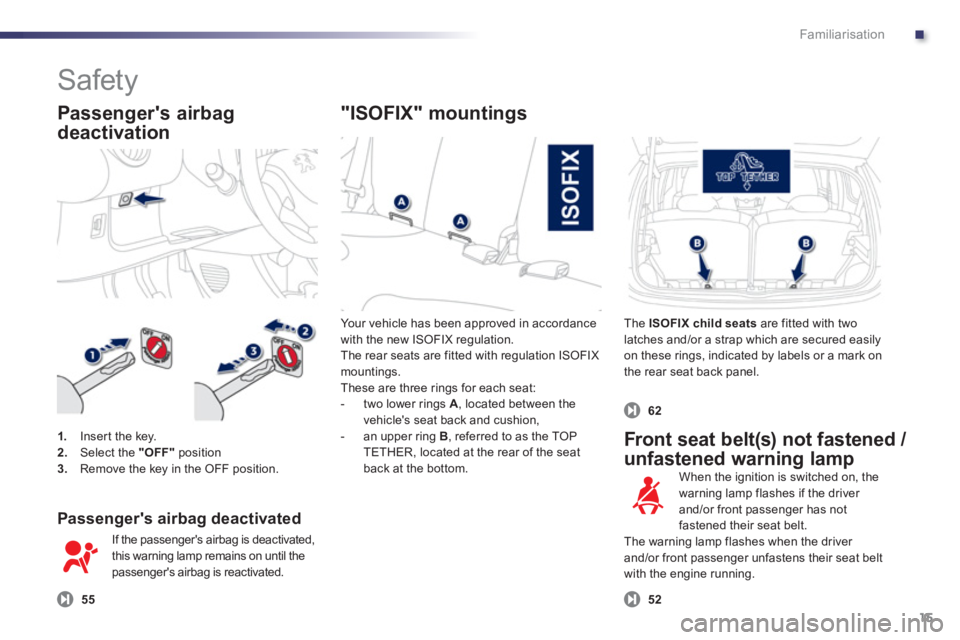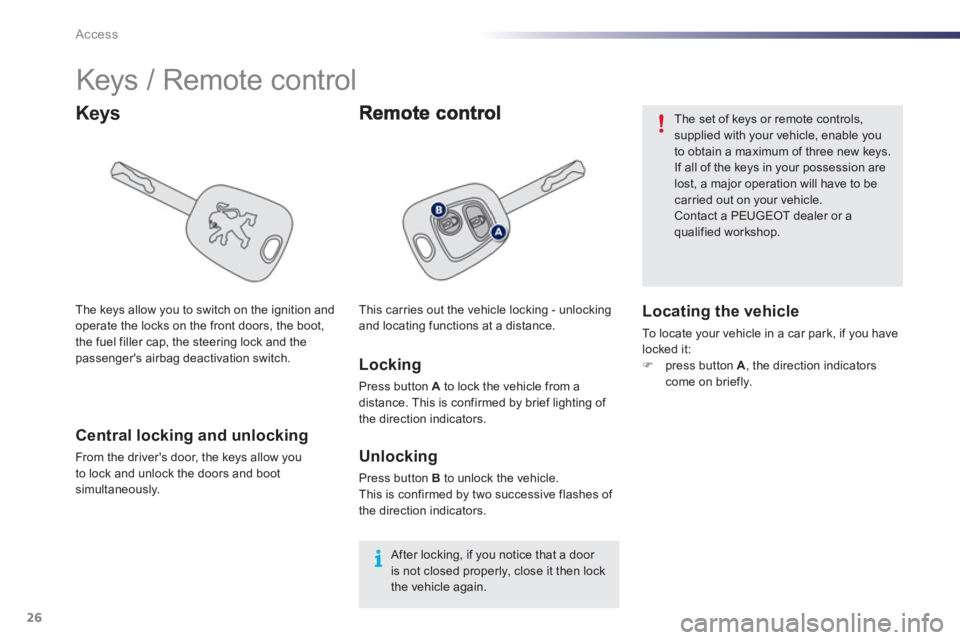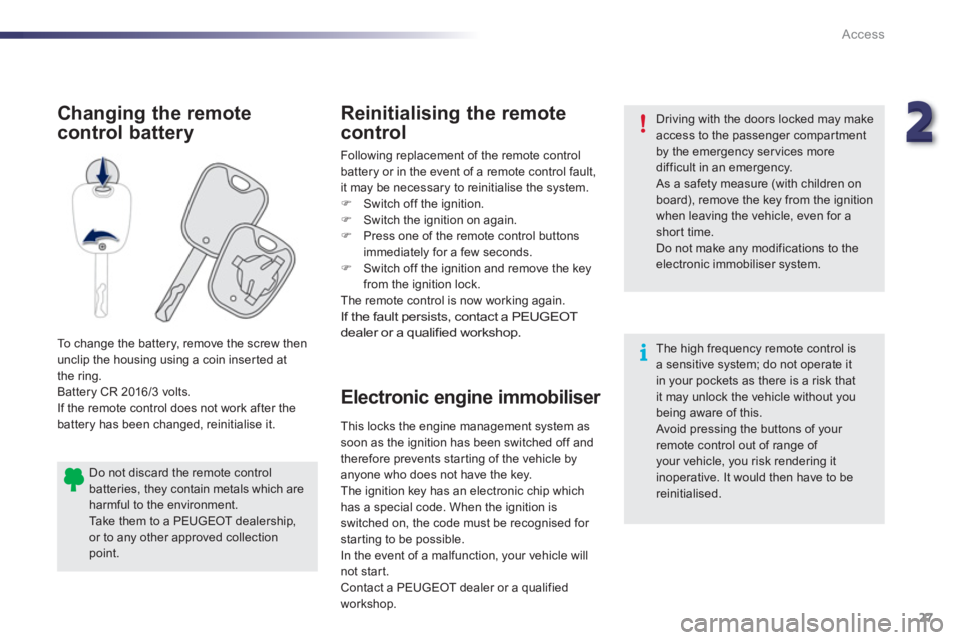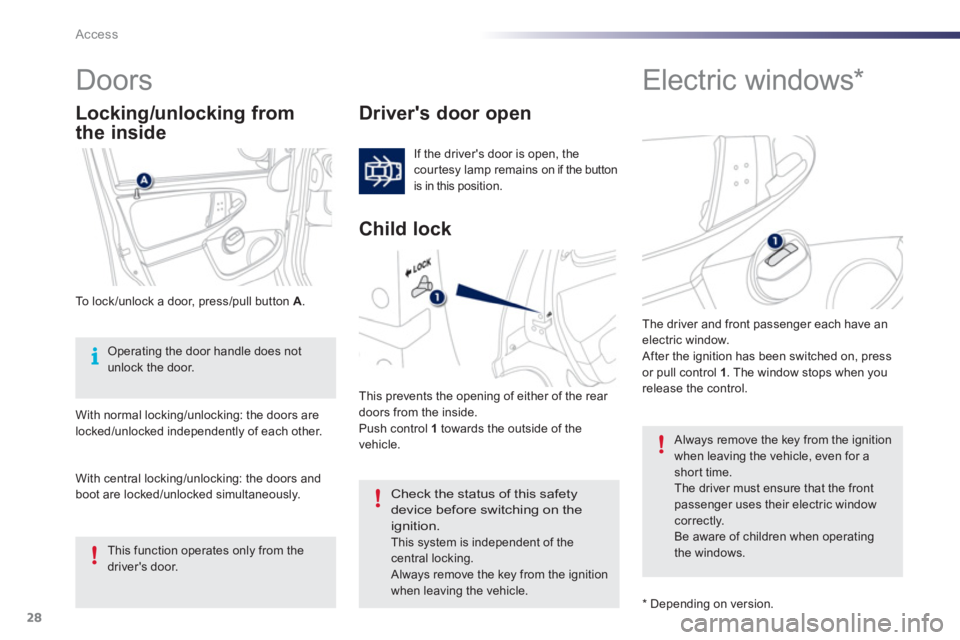Page 10 of 140
Familiarisation
8
1. Driver's door mirror control 2.Instrument panel3.Wiper stalk 4.
Steering lock and ignition
5. Hazard warning lamps
6.Storage compar tments 7. Diffusion grille 8.Windscreen demisting and defrosting vent
9.
Passenger's front airbag10.Adjustable side air vent 11.
Storage box 12.
Audio system 13.Ventilation, heating or air conditioning controls14 .Auxiliary socket for por table equipment15.Storage compar tments 16.
12 V socket (120 W max)17.Parking brake18.Driver's electric window control
Instruments and controls
Page 16 of 140
Familiarisation
14
When the ignition is on, the orange and red
warning lamps come on.
When the engine is running, these warninglamps should go off.
If warning lamps remain on, refer to the
information on the warning lamp in question.
A. Rev counter B.Screen C.Fuel gauge
The d
ynamic stability control system (ASR/ESP) optimises the vehicle's road holding.
For correct operation of the system, refer to the
relevant page.
Monitoring
Instrument panel
Warning lamps
ASR/ESP option
5020 1
9
Page 17 of 140

.Familiarisation
15
Your vehicle has been approved in accordancewith the new ISOFIX regulation.
The rear seats are fitted with regulation ISOFIX
mountings.
These are three rings for each seat:
- two lower rings A , located between the
vehicle's seat back and cushion,- an upper ring B
, referred to as the TOP TETHER, located at the rear of the seat back at the bottom.
The ISOFIX child seats
are fitted with two
latches and/or a strap which are secured easily on these rings, indicated by labels or a mark on
the rear seat back panel.
Passenger's airbag deactivated
If the passenger's airbag is deactivated,
this warning lamp remains on until thepassenger's airbag is reactivated.
Front seat belt(s) not fastened /
unfastened warning lamp
1.
Inser t the key. 2.Select the "OFF"
position3.Remove the key in the OFF position.
When the ignition is switched on, the
warning lamp flashes if the driver and/or front passenger has not fastened their seat belt.
The warning lamp flashes when the driver
and/or front passenger unfastens their seat belt
with the engine running.
Safety
Passenger's airbag
deactivation"ISOFIX" mountin
gs
556
2
52
Page 22 of 140

Instruments and controls
20
Warning lamps
Warning lampis onCauseAction/Observations
Parking brake
fixed. The parking brake is applied or not properly released. With
your foot on the brake pedal, release the parking brake
to switch off the warning lamp.
Observe the safety recommendations.
For more information, refer to the "Parkin
g brake" section.
STOP
fixed, associated
with another warning lamp.It is associated with the en
gine
oil pressure or the engine coolant temperature. Stop as soon as it is safe to do so.
Park, switch off the ignition and call a PEUGEOT dealer or qualified workshop.
Engine oilpressure
fixed, associated
with the STOP warning lamp.The en
gine oilpressure is too low.
Stop as soon it is safe to do so.
Park, switch off the ignition and contact a PEUGEOT dealer or a qualified workshop.
Braking
fixed. The braking system fluid level has dropped significantly. Top up with brake
fluid recommended by PEUGEOT.
If the problem persists, have the system checked by a
PEUGEOT dealer or a qualified workshop.
+
fixed, associated
with the ABSwarning lamp.The braking systemhas a fault. Stop as soon as it is safe to do so. Park, switch off the ignition
and contact a PEUGEOT dealer or a qualified workshop.
Page 23 of 140

1
VSC
Instruments and controls
21
Anti-lock Braking System (ABS)
fixed. The anti-lock braking system has a fault. The vehicle retains conventional brakin
g.
Drive carefully at reduced speed and contact a PEUGEOT
dealer or a qualified workshop without delay.
Electronicstability programme(ASR/ESP)
fixed. The ASR /ESP system is inaction. The system optimises traction and improves
the directional stability of the vehicle.
fix
ed. The ASR/ESP system has a fault. Have it checked by a PEUGEOT dealer or
a qualified workshop.
Coolanttemperature
fixed. The temperature of the engine coolant is too high.
Stop as soon as it is safe to do so.
Wait until the engine has cooled down before checking up thelevel; top up if necessary.
If the problem persists, contact a PEUGEOT dealer or qualified workshop.
Airbagstemporar
ily.This lamp comes on for a fewseconds when you turn on the
ignition, then goes off. This lamp should
go off when the engine is started.
If it does not go off, contact a PEUGEOT dealer or a qualified
workshop.
flashing. At least one of the airbags hasa fault. The airba
gs may not be deployed in the event of a serious
impact. Have it checked by a PEUGEOT dealer or a qualified
workshop.
Warning lampis onCauseAction/Observations
Page 28 of 140

26Access
Keys / Remote control
Keys
Locking
Press button A
to lock the vehicle from a
distance. This is confirmed by brief lighting of
the direction indicators.
Central locking and unlocking
From the driver's door, the keys allow you
to lock and unlock the doors and bootsimultaneously.
Unlocking
Press button B
to unlock the vehicle.
This is confirmed by two successive flashes of
the direction indicators.
Locating the vehicle
To l o c a t e your vehicle in a car park, if you havelocked it:�)press button A
, the direction indicators come on briefly.
The set of keys or remote controls, supplied with your vehicle, enable youto obtain a maximum of three new keys.
If all of the keys in your possession arelost, a major operation will have to be carried out on your vehicle.Contact a PEUGEOT dealer or a qualified workshop.
After locking, if you notice that a door is not closed properly, close it then lock the vehicle again. The ke
ys allow you to switch on the ignition and
operate the locks on the front doors, the boot,
the fuel filler cap, the steering lock and thepassenger's airbag deactivation switch. This carries out the vehicle lockin
g - unlocking
and locating functions at a distance.
Page 29 of 140

22
27 Access
Electronic engine immobiliser Chan
ging the remote
control battery
Reinitialising the remote
control
Following replacement of the remote control
batter
y or in the event of a remote control fault,it may be necessary to reinitialise the system. �) Switch off the ignition.�)
Switch the ignition on again.�)
Press one of the remote control buttons
immediately for a few seconds.�) Switch off the ignition and remove the key
from the ignition lock.The remote control is now working again.If the fault persists, contact a PEUGEOT
dealer or a qualified workshop.
Do not discard the remote controlbatteries, they contain metals which are harmful to the environment. Take them to a PEUGEOT dealership,
or to any other approved collection point. Driving with the doors locked may make
access to the passenger compar tment
by the emergency ser vices more
difficult in an emergency.
As a safety measure (with children on
board), remove the key from the ignition
when leaving the vehicle, even for a
shor t time.
Do not make any modifications to the
electronic immobiliser system.
To change the battery, remove the screw then
unclip the housing using a coin inserted at
the rin
g.
Battery CR 2016/3 volts.
If the remote control does not work after thebattery has been changed, reinitialise it. The high frequency remote control is
a sensitive system; do not operate it
in your pockets as there is a risk that
it may unlock the vehicle without you
being aware of this.
Avoid pressing the buttons of your
remote control out of range of
your vehicle, you risk rendering it
inoperative. It would then have to be
reinitialised. This locks the engine management system as
soon as the ignition has been switched off and
therefore prevents star ting of the vehicle byanyone who does not have the key.
The ignition key has an electronic chip whichhas a special code. When the ignition is
switched on, the code must be recognised for
starting to be possible.
In the event of a malfunction, your vehicle willnot start.Contact a PEUGEOT dealer or a qualifiedworkshop.
Page 30 of 140

28Access
Electric windows *
Doors
Driver's door open
If the driver's door is open, the
courtesy lamp remains on if the button
is in this position.
To lock /unlock a door, press/pull button
A.
With normal locking/unlocking: the doors are
locked/unlocked independently of each other. This prevents the openin
g of either of the rear doors from the inside.
Push control1 towards the outside of thevehicle.
Always remove the key from the ignition when leaving the vehicle, even for ashort time. The driver must ensure that the front passenger uses their electric window correctly.Be aware of children when operating the windows.
Operating the door handle does not unlock the door.
Check the status of this safety device before switching on the ignition.
This system is independent of the central locking. Always remove the key from the ignitionwhen leaving the vehicle.
Locking/unlocking from
the inside
This function operates only from the driver's door.
The driver and front passen
ger each have anelectric window.
After the ignition has been switched on, press
or pull control 1 . The window stops when you
release the control.
*
Dependin
g on version.
Child lock
With central locking/unlocking: the doors and
boot are locked/unlocked simultaneously.